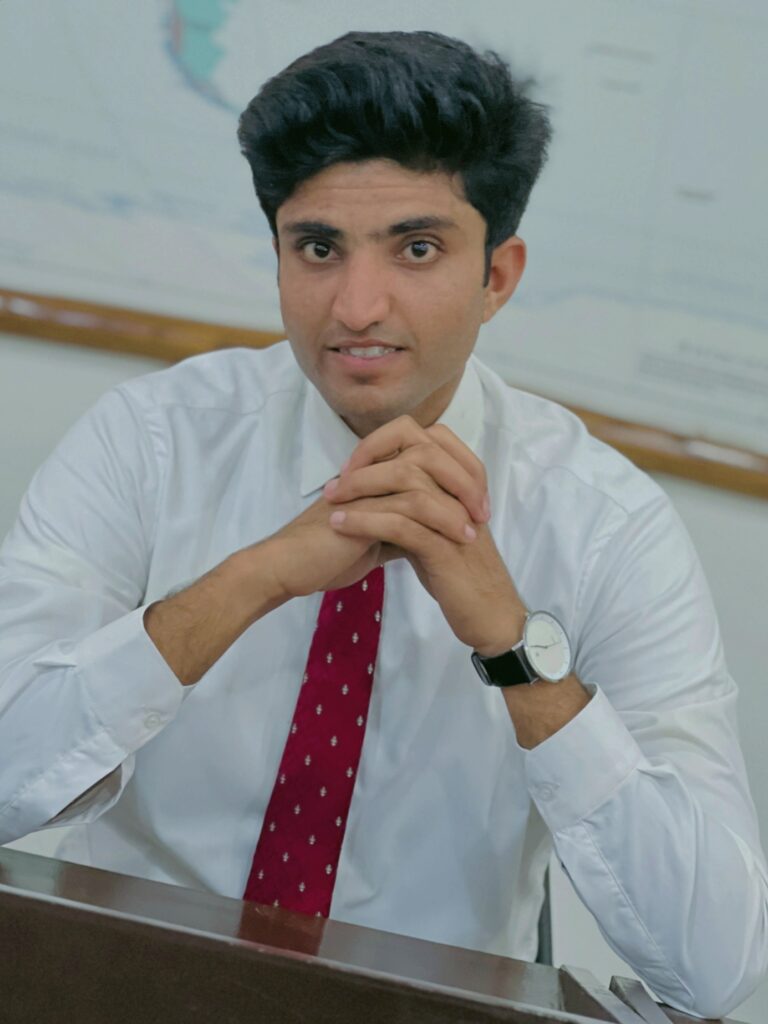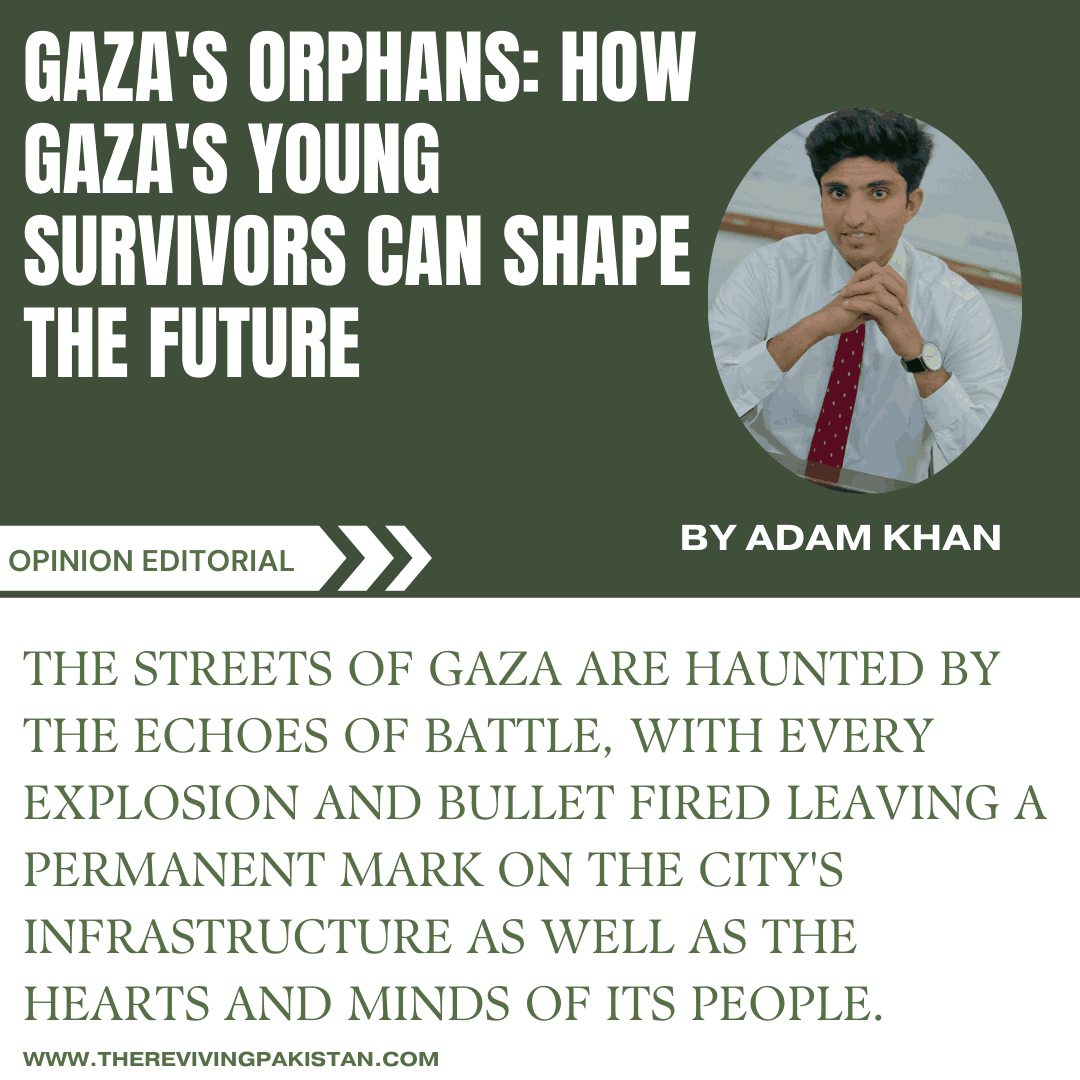About the Author(s)

Adam Khan
Author is a BS student in Peace and Conflict Studies at National Defence University, Islamabad. He is a frequent writer on global issues.
The streets of Gaza are haunted by the echoes of battle, with every explosion and bullet fired leaving a permanent mark on the city’s infrastructure as well as the hearts and minds of its people. The youngsters left orphaned by the violence are among those most severely impacted. They have lost their parents, they are developing a distinct outlook on life and a resistance. Driven by a strong mixture of sadness, rage, and a deep desire for revenge, these young souls, burdened with loss and a desire for justice, are set to become the leaders and warriors of the future.
Growing up ought to be a period of optimism rather than fear. And this is the time when kids ought to be playing, meeting new friends, and building memories as they get ready for the holidays. Unfortunately, for a lot of kids across the world, especially those in the Gaza strip are deprived of this. According to James Elder, UNICEF Global Spokesperson “Gaza is the most dangerous place in the world to be a child.”
The Israeli-Palestinian conflict has had a profound impact on the lives of Gaza’s youth, instilling in them a feeling of constant uncertainty and shaping their worldviews from an early age. These young people, who were raised in a setting characterized by ongoing violence, confront many difficulties, such as poor educational opportunities, inadequate access to healthcare, and ongoing risks to their physical and mental well-being. Growing up in an atmosphere where this ideological war predominates, Gaza’s children are greatly impacted by stories of resistance. Many of these kids have experienced the loss of friends and families in front of their eyes due to the violence, which has left them with a lasting trauma and a sense of resistance as a group identity.
According to the pattern, children who grow up in such environment of violence and deprivation are more vulnerable to radicalization. When homes, schools, and communities are destroyed, radical ideologies have an easier time spreading. Although refugee camps were designed to serve as temporary housing, many people now live there permanently due to the unforgiving living circumstances and ongoing threats, which accelerate the process of radicalization. These camps frequently act as breeding grounds for future combatants, since youth who have experienced loss and violence are drawn to ideologies that advocate for justice and retaliation. For instances, past conflicts like the Gaza War of 2008–2009 and war in 2014, have demonstrated that a large number of Hamas leaders and fighters were raised in refugee camps, and their upbringing in adversity and loss served as a catalyst for their dedication to the resistance movement.
For example, Yahya Sinwar, co-founder of the Hamas military wing, Izz ad-Din al-Qassam Brigades was born in the Khan Younis refugee camp in Gaza in 1962. He grew up in the harsh conditions of the camp, which significantly shaped his worldview and future actions. Similarly, Mohammed Deif, commander of Qassam Brigades was also born in the Khan Younis refugee camp in Gaza. Another leader of Hamas military wing, Marwan Issa grew up in the Nuseirat refugee camp in the central Gaza Strip. Likewise, Ayman Nofal was born and raised in the Bureij refugee camp in central Gaza. His experiences in the camp influenced his decision to join the resistance and became a senior commander in Qassam brigades.
Ibrahim Maqadma was also born and grew up in a refugee camp in Gaza known as Jubalia. The camp conditions greatly influenced his worldview, and he joined the resistance movement. One thing that is common in the life of all these individuals is that all of them were displaced in the early years of their life and they lost their loved ones in front of their eyes. They were deprived of necessities of life and could not get good education. On reaching the teenage, they all picked up weapon with a sense of getting revenge and made organized militant groups to fight against Israel. These individuals exemplify how life in refugee camps may encourage participation in resistance movements. Their experiences of displacement, hardship, and conflict have significantly shaped their paths, leading them from refugee camps to prominent roles in militant organizations.
The desire for revenge acts as motivation and holds personal significance for these orphaned children of Gaza. It is a way to honor the memory of their lost loved one. They become passionate warriors who are prepared to go through significant sufferings to accomplish their goals because of their personal connection to the conflict. In Gaza, where conflicts frequently interrupt official schooling, a large number of children seek out other types of education. Ideological education is given by resistance groups and local communities, who emphasize the value of standing up for one’s rights and the values of resistance. Orphans of Gaza learn about the history of their conflict and sacrifices of those who came before them, and the strategies of resistance. This information, together with their own experiences, strengthens their dedication to the cause.
Furthermore, this tendency is strengthened by Gaza’s familial and social networks. In a culture where nearly every family has experienced some sort of loss, the sadness and resolve that permeate the air normalize and even promote the desire for vengeance. Veterans of previous wars, elders, and community leaders frequently act as mentors and role models for the younger generation, carrying on the resistance movement.
The youth of Gaza are often seen by the world community as victims, with their suffering that ignores the determination of these young people. They are active contributors to their own fate rather than just passive beneficiaries of aid. Their transformation from abandoned kids to leaders of the resistance is evidence of their fortitude and the Gazan people’s unwavering resolve. The cycle of violence is set to recur as these kids get older. They are likely to create new combat organizations or restructure already-existing ones, driven by their sense of loss and retaliation.
As a result, the cycle of violence never ends, with each generation carrying the wounds of the last and motivated by the same thirst for revenge. Any chance of permanent peace is thwarted by this ongoing warfare, which keeps the wounds from the past open. In the absence of a long-term and all-encompassing solution, this cycle of violence will not stop. An ongoing state of violence will only increase the number of orphans, the amount of loss, and the thirst for retribution. The core causes of this conflict must be addressed to provide long-term stability and reconciliation and immediate alleviation. The children of Gaza will grow up in a society where the route to resistance is the most practical means of overcoming their pain and loss until such solutions are put into place.

